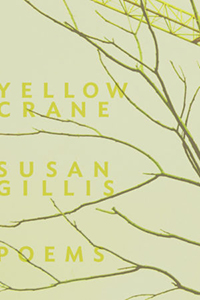Reviews
Poetry Review by Laura Ritland
Susan Gillis, Yellow Crane (London: Brick, 2018). Paperbound, 88 pp., $20.
 Susan Gillis’s ambitious, expansive Yellow Crane is a book of poetry about poetry. Two long, multi-sectional poems frame shorter lyrics that collectively meditate on the relationship between construction and destruction, form and ruin, mind and world. Like its own internal fixation on the interplay of light and shadow or the wind’s restless movements over “whorls” and “spirals” of hay (“Obelisk”), Yellow Crane settles and unsettles, decides and un-decides, embracing the movement between ideas rather than pinning them to rigid or static definitions.
Susan Gillis’s ambitious, expansive Yellow Crane is a book of poetry about poetry. Two long, multi-sectional poems frame shorter lyrics that collectively meditate on the relationship between construction and destruction, form and ruin, mind and world. Like its own internal fixation on the interplay of light and shadow or the wind’s restless movements over “whorls” and “spirals” of hay (“Obelisk”), Yellow Crane settles and unsettles, decides and un-decides, embracing the movement between ideas rather than pinning them to rigid or static definitions.
Gillis’s title names one of the collection’s central images: the construction crane—whose “yellow arm,” poised with its “counterweight” over a half-made building site, embodies Gillis’s ruminations on what it means to make “meaning” in poetry. The crane is a master signifier, literally “pointing up toward the sun” or away into geographic cardinals (“Ode”). It is also a tool for guiding poetic perception—what the poet “lean[s] on” when they “lean / into the place that had just been in view” (“Ode”). It structures the sky, “like a great square moon // maintaining a distance, always the same distance” (“Ode”), giving form to the formless and shape to the shapeless. Yet, Gillis’s crane, like her poetics, might be better thought of as less about celebrating the stability of structure than about trying to live in the unstable bind between form and formlessness, comprehension and incomprehension, construction and dis-assembly. Like a crane positioned over its building materials, Gillis’s poetry stands between the making of meaning (its “construction”) and the unravelling or uncertainty of stable meaning (its “debris”).
One example of how Gillis puts these abstract concepts into concrete application is through her use of negation in the collection. “Fieldwork,” a poem that narrates the speaker’s father’s illness, begins with the statement “No gesture is unreadable” in its third stanza and ends with its opposite in the second-last stanza, “All gestures are unreadable.” Such moments of contradiction reflect less a state of indecisiveness on Gillis’s part than her negotiation of opposites to arrive at a new (or perhaps just different) level of knowledge. As the speaker of the final poem, “A Story,” states, “This is how we reach knowledge of others: / finding what we cannot make understood.” The incomprehensible becomes a site for “knowledge.” Furthermore, knowledge itself in this collection is not stable. For example, what we know of other peoples’ lives, Gillis conveys, is like “snow”: “formed by solidification of elements / with regular repeating structures of atoms and faces,” yet inherently ephemeral in its very ice-like formation (“A Story”). Semantic clarity crystallizes only temporarily.
In her range between the concrete detail of a day-to-day life in poems like “A Story” or “Lost & Found” and moments of high lyric abstraction, Gillis dramatizes the way thought weaves between the materially particular and the mentally conceptual—with each term undoing the other. A moment of epiphanic transcendence ends with the speaker going “indoors” to their study and making coffee “as usual” (“A Story”). The mundane event of a salamander crossing the speaker’s path sparks quasi-mystical moment for writing about a “little flame licking across the road” (“Salamander”). But perhaps no other poem of the collection seeks to formally enact the complexity of Gillis’s thinking more than “Obelisk,” a long poem of thirty sections that composes roughly the first third of the book. With its allusions to other thinkers (John Dixon Hunt, Xi Chuan, Don McKay, Walter Benjamin, and especially Czesław Miłosz), and its footnotes explaining Gillis’s interests and reasons for engaging with her cited sources, the entire sequence reads like an essay, albeit a highly fragmented one. It includes first-person vignettes, personal memory, statements about poetry, visions of apocalyptic landscapes, an image of a house teetering on an abyss, and—finally, surprisingly—a bear. On first reading, the reason for these various fragments’ assembly seems unclear, even puzzlingly incoherent. However, that these pieces don’t quite fully connect may be Gillis’s point. To quote one of the classification systems Gillis toys with, if poetry navigates between the “large, unreachable, disturbing, dangerous, hostile, discomforting, / raw” and “norm, custom, habit, manner, rule, order, law” (“Obelisk”), then her presentation of an essay in fragments engages with both sides without choosing one. Poetry admits to ruin—both that of semantic ambiguity and the literal ruin of a polluted planet (of which “Obelisk” contains many familiar images). It also admits to “norm” and “custom”—the “yellow crane” which is human thought, semantic regularity, and poesis. Both construction and disintegration are inherent to the poetic process.
One wonders if there might be a third term between ruin and poesis: the bear’s wilderness, a site beyond which human thought can anticipate or grasp. Like Elizabeth Bishop’s moose, startling its bus passengers on a New Brunswick road, Gillis’s bear in the final section of “Obelisk” seems to come at us from nowhere. And perhaps aptly so: we are unsettled by what the world brings us—and poetry, Gillis conveys, rather than trying to build or destroy the world with its metal arm, pushes us to and beyond the edge of the tamely comprehensible.
—Laura Ritland









